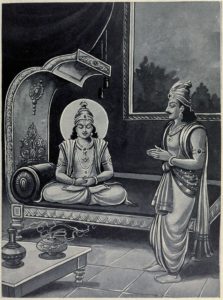Krishna starts off the Gita by asking Arjuna not to grieve – “Don’t cry for either the living or the dead” (BG 2.11). And he ends his message by asking Arjuna not to grieve – “Just have faith in me. I will grant you the ultimate state. Don’t cry” (BG 18.66). In between these two persuasions of “Don’t cry,” he teaches the Gita. But what of Krishna’s life? Has he ever cried? While all the great warriors of the Mahabharata have shed tears at some point of time or the other, Krishna never sheds a tear. There are instances where he is sad, but he doesn’t show it. In fact, even at the time of his birth, he is born with a smile. When he dies, he dies with a smile. He is a symbol of joy and peace. While his life has seen so much duality and turbulence, he has rarely gone through any mood swings. He has seen duality and he has dealt with it all through his life. And his teaching therefore is not idealistic, but rooted in reality.
In chapter 6 of the Gita, Krishna speaks a great deal about meditation (see for example, BG 6.10-15). We can see these verses in the light of an illuminating episode from the Mahabharata. After the war is won and Yudhisthira is to be crowned as king, Krishna is lost in thought. He thinks about Bhishma, the great warrior lying on the bed of arrows. Bhishma is a vast storehouse of theoretical knowledge and his wisdom would go waste if it wasn’t learnt by someone from the next generation. This great treasure should not be lost. He tells Yudhisthira, “Come, let us go learn from him.” Krishna doesn’t waste any time rejoicing the victory or getting honored for his decisive role in winning the war
When Yudhisthira goes to meet Krishna before embarking on his journey to meet Bhishma, he finds Krishna in a deep state of meditation (MB 12.46) His senses are totally under control and his entire being emanates a joy and peace that startles Yudhisthira. Just seeing him, one would find peace. His mind is still. His entire being is in bliss. He is shining. He has become one with everything. Yudhisthira says that Krishna is like a lamp that is sheltered from the wind. Those are the very words that Krishna uses to describe one in meditation (BG 6.19). Krishna then says that it is this yoga that drives him. Krishna enjoyed his life and brought happiness to others around him. He embraced life but didn’t care about the results.
In chapter 10, Krishna refers to the Supreme as the one that is the best among everything. It is a reminder for us to respect that which is splendid, marvelous, and exemplary. While the divine is everywhere, we specially respect those that are magnificent. While every river is a giver of life, we are struck by awe when we see a Brahmaputra. While every mountain towers over us, we are struck by wonder when we see the Himalayas. In other words, vibhuti yoga (the path of divine splendor) is a means of achieving oneness with the Supreme through rasa, the aesthetic experience. It is a means of recognizing merit everywhere. Krishna speaks of greatness in nature, in culture, in human psyche, and among humans. Taken another way, this is a direct attack on organized religion. There is no need for a mediator to reach the Supreme – it is available everywhere. He reiterates this message when he says “Forget all paths and take refuge in the Supreme” (BG 18.66).
This is why the Bhagavad-Gita is a song. It is neither prose nor poetry but song. When we are truly ourselves, we sing with joy. We sing the melodious song, which is life. The singer, the song, and the listener become one.
Within prison walls you were born
Separated from your parents at birth
Nurtured by the love of the unlettered
Even education remained incomplete
You were driven out constantly
from your own land and country
Insulted by peers as a low-born warrior
Family feuds, haughty wives, worthless sons
The only non-warrior in the greatest of wars
Even your Arjuna turned out to be a bad pupil
You died the most insignificant of deaths
And yet, never breathed a word of complaint
The world waited for your birth
Even as you duped death
Doer of heroic deeds
Stealer of women’s hearts
O kingmaker, world-teacher,
O friend of all beings
You had everything
Yet you remained without pride
– R Ganesh
References
Bhagavata Purana (Gorakhpur: Gita Press)
Critical Edition of the Mahabharata and the Harivamsha (in 5 volumes) edited by V S Sukhthanker et al. (Pune, Bhandarkar Oriental Research Institute: 1966)
The New Bhagavad-Gita by Koti Sreekrishna and Hari Ravikumar (Mason: W.I.S.E. Words, 2011)

















































